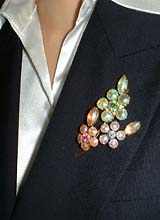BROOCHES ARE BACK:
Old-Fashioned Decor Finds New Following
March 2, 2001
|
 |
|
Elegant brooches add a dash of individuality to plain business attire.
|
There has appeared to be a one-way shift in the fashion of Japanese youth toward the casual end of the spectrum over the past few years. Winter 2000-01, however, has brought about a revival of elegant styles. Department store managers say the most popular fashion items are those with a touch of opulence. For the first time in a long while, brooches are a hit, and those featuring cut glass on metal are selling particularly well at department stores, as are flower-shaped brooches of fabric or leather. As the preference for wild, thoroughly tanned skin and brick-like platform shoes gradually gives way to an affinity for whiter complexion and elegant clothing, young women are rediscovering the merits of brooches--once seen as being exclusively for middle-aged women--in spicing up their fashion.
Coming in Various Styles
Department stores are giving brooches a prominent spot in their sales areas, while accessory makers are enriching their lineup of brooches. Coarsely woven fabrics like tweed are currently in style, and brooches are popularly worn on the collars of coats and jackets made of such cloth, counterbalancing the cloth's coarseness by adding to it a delicate touch. They are also often used to fasten scarves.
Classical motifs, such as flowers and insects, tend to be preferred for metal brooches. Rather than items garnished with expensive materials, such as pearl and precious stones, young women are going primarily for moderately priced varieties using color glass, costing anywhere from 1,000 to 5,000 yen (8.70 to 43.50 U.S. dollars at 115 yen to the dollar).
Women in their thirties and upward are also opting for vintage brooches embellished with Bohemian glass or glass pearls, made in Europe in the 1940s and 1950s. These usually cost between 30,000 and 50,000 yen (261 and 435 dollars), but their popularity has been such that outlet shops have been set up in department stores. Among pushpin types for blazers and suits, meanwhile, highly affordable variations--featuring fake pearls or rhinestones, for example--are expected to come into the mainstream from spring 2001 onward, targeting new company recruits, who in Japan are mostly employed in April.
Brooches of fabric or leather (or sometimes even knitted yarn) crafted into the shape of a single flower, such as camellia or rose, are equally popular. They come in almost every color imaginable, but the favorites are pastels, such as pink, light blue, and cream. As for the material, organdy and satin types are selling particularly well. Fluffy flower brooches made of pashmina--the silky cashmere fabric, used mainly for shawls, that have been taking the world by storm for the last year or two--are registering brisk sales. Many of these brooches have both a clip and a pin attached, so that they can be worn on the hair as well as on clothes.
A Twist to the Usual Fashion
As coats tend to be rather expensive, the majority of people do not own a large variety of them or buy new ones every year. By wearing different brooches on one's usual coat, however, one can change the coat's impression. Moreover, brooches have a functional aspect, as they can be used for fastening scarves and shawls. Some experts predict that as the weather grows milder, warmer hues--such as orange--as well as purple and green will come into vogue.
Over the past several years, young people have been striving to give a flavor of individuality to their fashion while conforming to the trends of the day, such as by adding a highly feminine element to a sporty outfit. Brooches have come back in favor, it seems, as ideal tools for brushing up young women's fashion with an elegant touch.
Back to Main Index
 Copyright (c) 2001 Japan Information Network. Edited by Japan Echo Inc. based on domestic Japanese news sources. Articles presented here are offered for reference purposes and do not necessarily represent the policy or views of the Japanese Government. Copyright (c) 2001 Japan Information Network. Edited by Japan Echo Inc. based on domestic Japanese news sources. Articles presented here are offered for reference purposes and do not necessarily represent the policy or views of the Japanese Government.
|



















